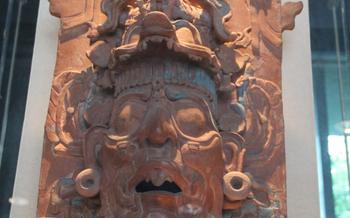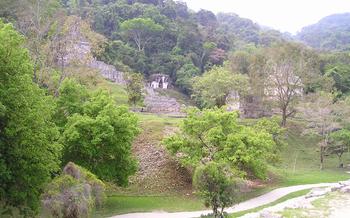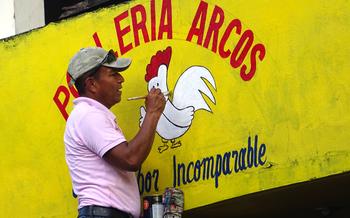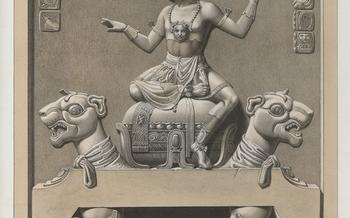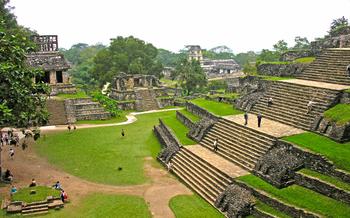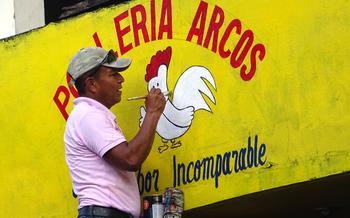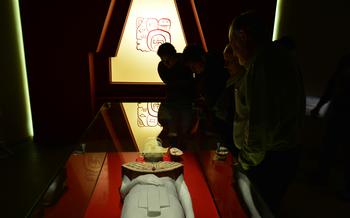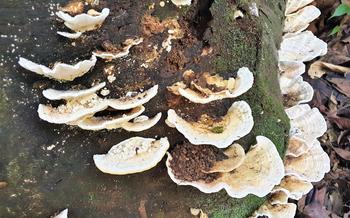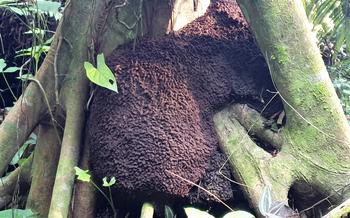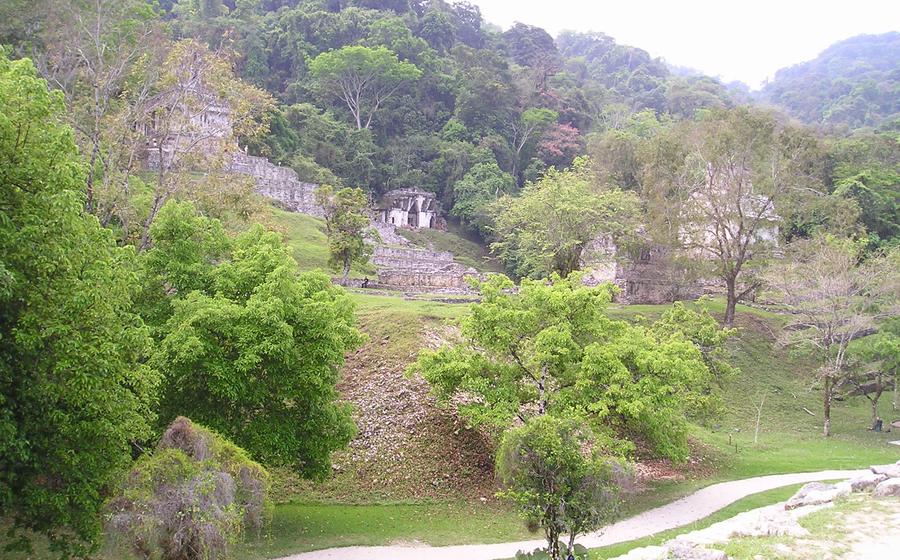
Temple of the Cross
- Historical Significance
- Location and Getting There
- Architectural Features
- History and Construction
- The Cross Group: A Sacred Complex
- Significance of the Name
- Ancient Rituals and Ceremonies
- Restoration and Preservation Efforts
- Myths and Legends
- Tips for Visiting
- Nearby Attractions
- Local Cuisine and Restaurants
- Cultural Experiences
- Sustainable Tourism
- Insider Tip: Unveiling Hidden Gems and Capturing Timeless Moments
Historical Significance
Palenque, a captivating ancient city nestled in the heart of the Maya civilization, flourished during the Classic period (250-900 AD). The Temple of the Cross, one of its most iconic landmarks, stands as a testament to the Maya's architectural prowess and intricate belief system. This grand edifice served as a sacred site for religious rituals, political ceremonies, and astronomical observations, playing a pivotal role in the spiritual and cultural life of the ancient Maya.
The architectural style of the Temple of the Cross showcases the Maya's mastery of construction techniques. Its intricate facade adorned with stucco reliefs depicts elaborate scenes from Maya mythology, while its interior chambers reveal hidden passages and burial crypts. The temple's significance extends beyond its architectural beauty; it represents a fusion of religious and political power, serving as a symbol of the divine authority of Palenque's rulers.
In recognition of its exceptional cultural and historical value, the Temple of the Cross, along with the entire archaeological site of Palenque, was designated a UNESCO World Heritage Site in 198This accolade underscores the temple's importance as a cherished symbol of Maya civilization, a treasure that continues to inspire and awe visitors from around the globe.
Location and Getting There
The Temple of the Cross is situated within the ancient city of Palenque, a significant archaeological site located in the southern Mexican state of Chiapas. It is nestled amidst the lush greenery of the Selva Lacandona, a tropical rainforest region, and is an integral part of the Palenque National Park. The site can be reached via the nearest airport, Palenque International Airport, which offers domestic flights from major cities in Mexico. From the airport, various transportation options are available to reach Palenque town, which is located approximately 10 kilometers from the archaeological site. Organized guided tours and day trips from popular tourist destinations like Cancun and Playa del Carmen are also available for visitors seeking a comprehensive and hassle-free experience.
Architectural Features
The Temple of the Cross stands out for its unique architectural style, showcasing the advanced craftsmanship and artistic prowess of the Maya civilization. Its exterior boasts intricate carvings and bas-reliefs depicting mythological scenes, deities, and historical events. The main facade features a central staircase flanked by two towers, adorned with human figures and elaborate stucco decorations. The temple's interior is equally impressive, consisting of a series of interconnected chambers and galleries, each with distinct features and decorations. The walls are adorned with well-preserved murals, depicting various rituals, ceremonies, and scenes from Maya mythology. These murals provide valuable insights into the religious beliefs, social customs, and daily life of the ancient Maya. The temple's roof is adorned with a unique and well-preserved roof comb, a distinctive feature of Maya architecture. The roof comb is elaborately carved with intricate designs and figures, representing deities, rulers, and other important symbols. The overall design and iconography of the Temple of the Cross reflect the Maya's deep understanding of astronomy, mathematics, and their complex religious beliefs.
History and Construction
The Temple of the Cross was constructed during the Late Classic period of Maya civilization, around the 7th century AD. It underwent several modifications and additions over time, reflecting the evolving political and religious landscape of Palenque. Initially, the temple was a relatively modest structure, consisting of a single chamber with a corbelled vault. However, it was later expanded and embellished with elaborate carvings and sculptures, transforming it into one of the most impressive temples in the city.
The construction of the temple involved a combination of techniques and materials. The core of the structure was built using large limestone blocks, quarried from nearby sites. These blocks were carefully cut and fitted together without the use of mortar, demonstrating the remarkable engineering skills of the Maya. The exterior of the temple was adorned with intricate carvings and sculptures, depicting various deities, rulers, and mythological scenes. The use of stucco, a type of plaster made from lime and aggregate, allowed the Maya artists to create fine details and lifelike representations.
The construction of the Temple of the Cross was a testament to the power and prestige of the Maya rulers. It served as a center for religious rituals and ceremonies, and its elaborate decoration reflected the importance of the Maya religion. The temple also functioned as a symbol of the ruler's authority and connection to the divine realm, reinforcing his legitimacy and power.
The Cross Group: A Sacred Complex
The Temple of the Cross is part of a larger complex known as the Cross Group, an important ceremonial and religious center within the ancient city of Palenque. This group of structures is named after the Temple of the Foliated Cross, another significant temple located nearby. The Cross Group includes several other temples, palaces, and altars, each with its own unique architectural features and symbolic significance.
The Temple of the Foliated Cross, situated to the west of the Temple of the Cross, is known for its intricate carvings and bas-reliefs depicting scenes from Maya mythology and history. The Temple of the Sun, located to the south, features a circular design and is believed to have been used for astronomical observations. The Palace, situated to the east of the Temple of the Cross, served as the administrative and residential center of Palenque's rulers.
The Cross Group represents a microcosm of Maya culture, showcasing their architectural prowess, religious beliefs, and political organization. Together, these structures form a complex that played a central role in the spiritual and civic life of the ancient Maya city of Palenque.
Significance of the Name
The Temple of the Cross derives its name from a distinctive stone cross carved on the lintel above the entrance to the temple's interior chamber. This cross, a rare and enigmatic symbol in Maya iconography, is believed to have religious and symbolic significance. Some scholars suggest that the cross represents the sacred tree or world tree, a central motif in Maya mythology that symbolizes the connection between the underworld, the earth, and the heavens. Others believe that it may represent the four directions, or the four winds, which were important elements in Maya cosmology. The cross may also have been a symbol of the Maya ruler, who was seen as a mediator between the gods and the people.
The name "Temple of the Cross" was given to the temple by early explorers who encountered the site in the 19th century. The name has since become widely accepted and is used to distinguish the temple from others in the ancient city of Palenque. The cross remains a prominent symbol associated with the temple, and it continues to be a source of fascination and speculation among visitors and scholars alike.
Ancient Rituals and Ceremonies
The Temple of the Cross, with its elaborate carvings and symbolic imagery, was likely the site of various religious rituals and ceremonies in ancient times. It is believed to have been a place of worship and reverence, where the Maya people sought to connect with their gods and ancestors. Archaeologists have uncovered evidence of offerings, including pottery, jade, and incense, which were left at the temple as a form of devotion or petition. Sacrifices, both animal and human, may have also taken place, as evidenced by the discovery of sacrificial altars and remains. The Temple of the Cross played a significant role in the spiritual and religious life of the Maya, serving as a sacred space for rituals, ceremonies, and communion with the divine.
Restoration and Preservation Efforts
The Temple of the Cross, like many other ancient Maya structures, has undergone extensive restoration and preservation efforts to protect its historical and cultural significance. In the early 20th century, archaeologists and conservators began to document and study the temple, leading to the first major restoration project in the 1950s. This project focused on stabilizing the temple's structure, removing vegetation, and repairing damaged areas.
In the 1970s and 1980s, further restoration work was carried out, including the reconstruction of fallen walls and the consolidation of the temple's facade. Conservators also worked to clean and preserve the temple's intricate carvings and sculptures, using techniques such as laser cleaning and chemical treatments.
Ongoing conservation projects continue to monitor and maintain the Temple of the Cross. These efforts include regular inspections, documentation of any changes or damage, and the implementation of preventive measures to protect the temple from environmental factors and human impact. By preserving this ancient masterpiece, future generations can continue to appreciate and learn from the rich cultural heritage of the Maya civilization.
Myths and Legends
The Temple of the Cross is shrouded in a rich tapestry of myths and legends, passed down through generations by the Maya people. One captivating tale tells of a powerful ruler named Pakal, who was believed to have ascended to the heavens from the temple's summit. According to legend, Pakal transformed into a resplendent bird, soaring high above the jungle canopy and disappearing into the celestial realm.
Another myth suggests that the temple was a sacred site for communication with the gods. It was believed that the Maya priests would gather at the temple to perform elaborate rituals and ceremonies, seeking guidance and blessings from the divine. Offerings of precious objects, such as jade, gold, and incense, were made to appease the gods and ensure their favor.
Archaeological evidence unearthed at the site seems to corroborate some of these legendary tales. Excavations have revealed numerous artifacts and offerings, including jade beads, ceramic vessels, and animal bones, hinting at the temple's significance as a religious and ceremonial center. These discoveries, coupled with the enduring oral traditions of the Maya people, help to paint a vivid picture of the temple's mythical and spiritual dimensions.
Tips for Visiting
To fully appreciate the beauty and significance of the Temple of the Cross, consider visiting during the dry season (November to April) when the weather is pleasant, and there are fewer crowds. Remember to dress appropriately for exploring the temple, as the weather can get hot and humid. Light, breathable clothing and comfortable shoes are recommended.
Photography enthusiasts should note that tripods are not allowed inside the temple, but handheld photography is permitted. Guided tours are available for those who want to learn more about the temple's history and significance.
When visiting the temple, take your time to explore the surrounding area, including the lush jungle and other notable structures within the Cross Group. Be sure to bring water and snacks, as there are no food or beverage options available at the temple.
Nearby Attractions
In addition to the Temple of the Cross, Palenque offers a wealth of other captivating attractions that beckon travelers to explore its rich history and natural splendor. The Palace, with its elaborately carved facades and intricate stucco decorations, stands as a testament to the architectural prowess of the Maya. Its grand courtyards, once bustling with the activities of the royal court, now invite visitors to wander through time and imagine the grandeur of a bygone era.
Equally impressive is the Temple of the Inscriptions, renowned for its towering height and the intricately carved hieroglyphic panels that adorn its exterior. Within its confines lies the tomb of the legendary ruler K'inich Janaab' Pakal, whose elaborate sarcophagus, discovered in 1952, remains one of the most significant archaeological finds in Mesoamerica.
For those seeking a refreshing respite from the ancient ruins, a visit to the nearby Agua Azul waterfalls offers a delightful opportunity to commune with nature. Cascading over a series of limestone terraces, these mesmerizing waterfalls create a breathtaking spectacle, inviting visitors to swim in the crystal-clear pools below or simply bask in the tranquility of the surroundings.
Another natural wonder worth exploring is the Misol-Ha waterfall, located a short distance from Palenque. Plunging over a sheer cliff into a picturesque pool below, this waterfall offers a stunning display of nature's power and beauty. Visitors can take a refreshing dip in the pool or embark on a scenic hike through the surrounding jungle, encountering a symphony of tropical birds and exotic flora along the way.
For those with more time to spare, consider venturing beyond Palenque to explore the nearby archaeological sites of Yaxchilán and Bonampak. Situated deep within the Lacandon Jungle, these hidden gems offer a glimpse into the lives of the ancient Maya, with their impressive architecture, intricate carvings, and well-preserved murals.
Local Cuisine and Restaurants
Palenque offers a diverse culinary scene that enchants the taste buds with its traditional Maya flavors. To truly immerse yourself in the local experience, savor the delectable dishes prepared with fresh, locally sourced ingredients. Must-try dishes include pibil, a succulent pork dish cooked in banana leaves, and panuchos, crispy tortillas topped with beans, shredded turkey, and a tangy tomato sauce.
For an authentic dining experience, venture into the heart of Palenque's vibrant markets, where you'll find an array of street food stalls serving up mouthwatering delicacies. Indulge in tamales, steamed cornmeal dumplings filled with savory fillings, or sopes, thick corn tortillas topped with beans, meat, and salsa.
For a more refined dining experience, visit one of the many local restaurants near the Temple of the Cross. These establishments offer a delightful fusion of Maya and Mexican cuisine, with dishes such as cochinita pibil, slow-roasted pork marinated in achiote paste, and pollo en escabeche, chicken stewed in a tangy sauce.
Whether you prefer the bustling atmosphere of a market or the tranquil ambiance of a restaurant, Palenque's culinary delights will leave you craving for more. Remember to embrace the local flavors and support the community by dining at establishments that prioritize sustainability and fair trade practices.
Cultural Experiences
Palenque offers a wealth of opportunities to immerse yourself in the vibrant Maya culture. Enhance your visit by attending traditional dance performances that showcase the region's rich heritage. These captivating shows bring to life the ancient stories and legends of the Maya, allowing you to witness the continuation of their cultural traditions.
Participate in hands-on workshops and demonstrations to learn traditional Maya skills, such as weaving, pottery, and cooking. These interactive experiences provide a deeper understanding of Maya craftsmanship and the importance of preserving these skills for future generations.
Venture beyond the temple and explore local villages and communities to interact with the Maya people firsthand. Engage in conversations, learn about their daily lives, and gain insights into their customs and traditions. This cultural exchange offers a unique opportunity to connect with the living legacy of the Maya civilization.
Shopping for traditional crafts and souvenirs is another way to support local artisans and take a piece of Maya culture home with you. Browse the vibrant markets and shops for handmade textiles, intricately painted pottery, and beautifully carved wooden figurines. These souvenirs not only serve as mementos of your visit but also contribute to the preservation and promotion of Maya artistry.
Throughout the year, Palenque hosts cultural festivals and events that celebrate the region's heritage. These lively gatherings feature traditional music, dance, food, and artesanía, providing an immersive experience of Maya culture. Don't miss the opportunity to participate in these vibrant celebrations and connect with the local community.
Sustainable Tourism
As a responsible traveler, it's important to prioritize sustainable tourism practices when visiting Palenque and the Temple of the Cross. Here are a few tips to ensure your travels align with sustainability principles:
- Minimize Environmental Impact: Avoid using single-use plastics, such as water bottles, and opt for reusable alternatives. Dispose of trash responsibly and respect the natural surroundings by not littering.
- Support Local Communities: Choose locally-owned restaurants, hotels, and tour operators that support the local economy. Prioritize purchasing souvenirs from local artisans and craftspeople to contribute to community development.
- Respect Local Customs: Be respectful of Maya traditions and customs. Ask permission before taking photos of people or sacred sites, and dress appropriately for the occasion.
- Choose Responsible Tour Operators: Research tour operators that prioritize sustainability and responsible practices. Look for operators that work with local guides, support conservation efforts, and adhere to ethical guidelines.
By embracing sustainable tourism, you can help preserve the cultural and natural heritage of Palenque for future generations while supporting local communities and contributing to their well-being.
Insider Tip: Unveiling Hidden Gems and Capturing Timeless Moments
As you explore the Temple of the Cross, venture beyond the main tourist paths to discover hidden corners and lesser-known attractions that offer unique perspectives and experiences. One such spot is the secluded Temple of the Sun, nestled amidst the lush vegetation just a short walk from the Temple of the Cross. This lesser-visited temple offers a serene ambiance and an opportunity to appreciate the intricate carvings and architectural details up close.
For photography enthusiasts, the Temple of the Cross presents countless opportunities to capture stunning images. Arrive early in the morning or late in the afternoon to take advantage of the golden light that illuminates the temple's facade, casting dramatic shadows and enhancing its grandeur. Experiment with different angles and perspectives to capture unique shots that showcase the temple's intricate details and its harmonious blend with the surrounding jungle.
Finally, for a breathtaking panorama of the temple and the surrounding jungle, head to the mirador, a designated viewpoint located a short distance from the Temple of the Cross. From this vantage point, you can capture sweeping views of the temple, the lush vegetation, and the distant mountains, creating a postcard-perfect moment that encapsulates the essence of this ancient Maya city.
